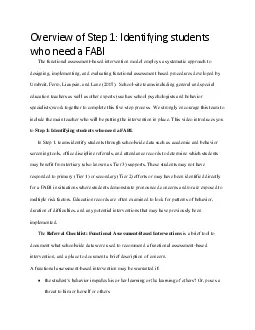

Step 1 Identifying students who need a FABIThe functional assessmentbased intervention model employs a systematic approach to designing implementing and evaluating functional assessment based procedu ID: 868901
Download Pdf The PPT/PDF document "hverview of" is the property of its rightful owner. Permission is granted to download and print the materials on this web site for personal, non-commercial use only, and to display it on your personal computer provided you do not modify the materials and that you retain all copyright notices contained in the materials. By downloading content from our website, you accept the terms of this agreement.
1 hverview of Step 1 : Identifying studen
hverview of Step 1 : Identifying students who need a FABI The functional assessment - based intervention model e mploys a systematic approach to d esigning, implementing, and evaluating functional assessment based procedures developed by Umbreit, Ferro, Liaupsin, and Lane (2007). School - site teams including general and special education teachers as well as other experts ( such as school psychologist s and behavior specialists) work together to complete this five - step process. We strongly encourage this team to include the main teacher who will be putting the intervention in place. This video introduces you to Step 1: Identify ing students who need a FA BI . In Step 1, teams identify students through schoolwide data such as academic and behavior screening tools, office discipline referrals, and attendance records to determine which students may benefit from tertiary ( also known as Tier 3) supports. These students may not have responded to primary (Tier 1) or secondary (Tier 2) efforts or may have been identified directly for a FABI in situations where students demonstrate pronounced concerns and/or are exposed to multiple risk factors . Education records a re often examined to look for patterns of behavior, duration of difficulties, and any potential interventions that may have previously been implemented. The
2 Referral Checklist: Functional Assessme
Referral Checklist: Functional Assessment - Based Interventions is a brief tool to document what schoolwide data were used to recommend a functional assessment - based intervention, and a place to document a brief description of concern. A functional assessment - based intervention may be warranted if: the stu dent’s behavior impedes his or her learning or the learning of other s ? Or, pose s a threat to him or herself or others the student’s been non - responsive to other intervention efforts the student has multiple risk factors (such as screened as high risk on a systematic screener for behavior or high mobility) making him or her more susceptible to school failure and/or dangerous behavior? The student has been (a) placed in an alternative setting for behavior dangerous to him or herself or others (b) placed in an alternative setting for 45 days due to drug or weapon s violations? Or (c), has the student been suspended from school for more than 10 days or has that suspension resulted in a change in placement? If you answered yes to the latter, a FABI is mandated by the Individuals with Disabilities Education Act (IDEA, 2004). For this step, it is also important to follow district procedures as well as federal, state, and local laws for obtaining necessary permissions . In subseq
3 uent videos, you will be introduced to
uent videos, you will be introduced to the remaining steps of this systematic five - step process. In Step 2: Conducting the Functional Assessment , you will learn about the functional assessment process where we discover reasons why challenging behaviors occur ( the function) . From there, teams p rogress to Step 3: Collecting Baseline Data , which will focus on behavior measurement recording and baseline procedures for how we will measure present levels before introducing the intervention. In Step 4: Designing the Intervention , we will introduce you to the Function Based Intervention Decision Model where we learn how to pick an appropriate method including antecedent adjustments, shifts in reinf orcement contingencies, and extinction components. Finally, in Step 5: Testing the Intervention we will discuss how single case design s with social validity and treatment integrity can be used to monitor and evaluate the effectiveness of the intervention. To learn more about this process, we encourage you to watch our video on Behavioral Data Collection . Y ou may also review Applied Behavior Analysis (2nd edition) by Cooper, Heron and Heward (2007) and Functional Behavior Assessment and Function - Based Intervention: An Effective, Practical Approach by Umbreit, Ferro, Liaupsin, and Lane (2007)